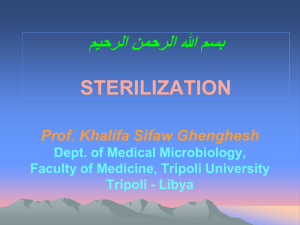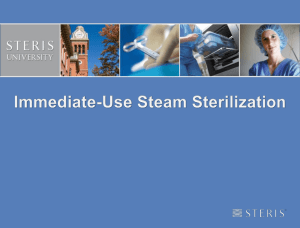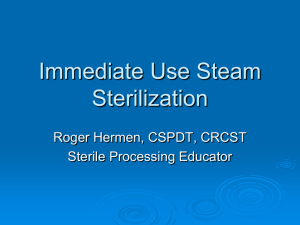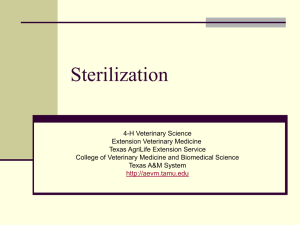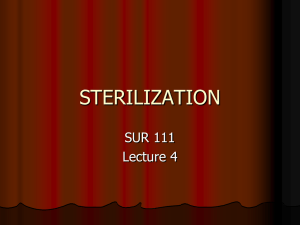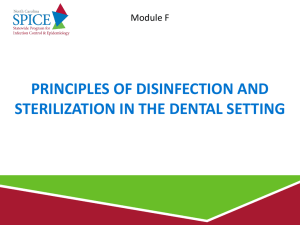Sterilization
advertisement
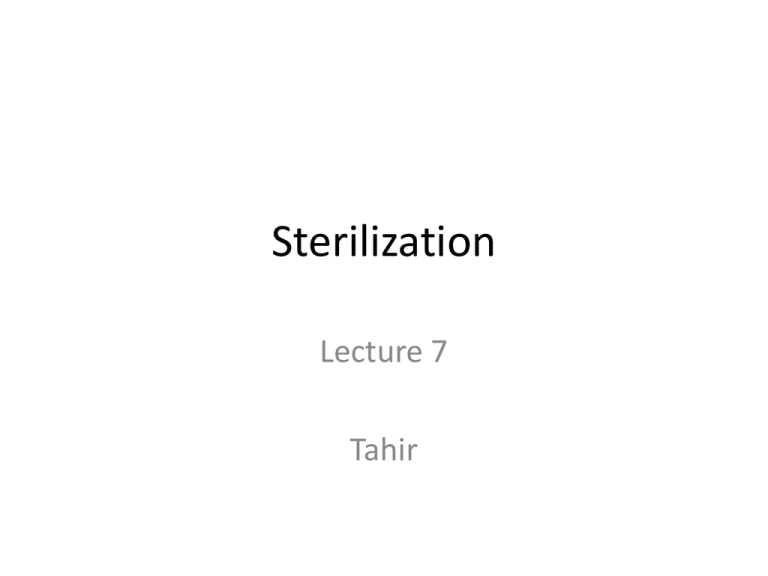
Sterilization Lecture 7 Tahir A fermentation product is produced by the culture of a certain organism, or organisms in a nutrient medium. If the fermentation is invaded by a foreign microorganism then the following consequences may occur: Avoidance of contamination may be achieved by: 1. Using a pure inoculums to start the fermentation. 2. Sterilizing the me dium to be employed 3. Sterilizing the fermnter vessel 4. Sterilizing all material to be added to the fermentation during the process. 5. Maintaining aseptic condition during the fermentation. Medium sterilization • • • Media may be sterilized by filtration, radiation ultrasonic treatment, chemical treatment or heat. However, for practical reasons, STEAM is used universally. Major exception is the use of filtration for the sterilization of media for animal cell culture – such media are completely soluble and contain heat labile components making filtration the method of choice. ‘ The destruction of micro organisms by steam may be described as a first order chemical reaction and thus may by represented by the following equation: •The relationship in above Fig would be observed only with the sterilization of a pure culture in one physiological form, under ideal sterilization conditions •The value of K is not only species dependent, but depended on the physiological form of the cell. •Eg. Endopsore of the genus Bacillus are far more heat resistant than the vegetative cells. • As with any first order reaction, the reaction rate increases with increase in temperature due to an increase in the reaction rate constant, which, in the case of the destruction of micro-organisms, is the specific death rate (K). • Thus K is the true constant only under constant temperature conditions. • The relationship b/w Temp & the reaction rate constant was demonstrated by Arrhenius & may be represented by the equation: •It is clear that the same degree of sterilization may be obtained over a wide range of time & temp. •This kinetic description of bacterial death enables the design of procedure for the sterilization of fermentation broths. •By choosing a value for Nt procedure may be designed having a certain probability of achieving sterility, based upon the degree of risk that is considered acceptable. •Only microbial contaminants present are spores of Bacillus stearothermophilus (most heat resistant) •Bacillus macerans suspended in oil were ten times more resistant to sterilization if they were dry than if they were wet. • Time & temp may now be determined to achieve the desired Del factor. • Deleterious reactions may occur in the medium during the sterilization process, resulting in loss of nutritive quality. •Deleterious effect of increasing medium sterilization time on the yield of product of subsequent of fermentations. •Initial rise in yield is due to some component of the medium being made more available to the process micro-organism by the “Cooking Effect” of a brief sterilization period. •Two types of reactions contribute to the los of nutrient quality during sterilization: 1. Interactions b/w nutrient components of the medium 2. Degradation of heat liable components. • The thermal destruction of essential media components conforms approximately with first order reaction kinetics, may be describe by equation similar to derived for destruction of bacteria: Decline in conc. Of the nutrient components, along with decline in the no of contaminants. The effect of temp on the reaction rate constant may be expressed by the Arrhenius equations: Therefore, a plot of natural logarithm of the reaction rate against 1/T will give a straight line, slope - (E/R). As R (gas constant) is fixed, the slope of the graph is determined by the value of the activation energy (E). E.g the value of E for B. stearothermophilus spores has 67.7Kcal/mole, whereas the thermal destruction of the nutrients is 10 -30 kcal/mole (Richard 1968) •From this plot it may be seen that as temp increased, the reaction rate rises more rapidly for the reaction with higher activation energy. Thus, considering the difference b/w activation energies for spore destruction & nutrient degradation, an increase in temp would accelerate spore destruction more than medium de-naturation. • Del factor could be achieved over a range of temp/time regimes. So high temp for a short time to achieve desired probability of sterility, with minimum nutrient degradation. Advantages of continuous sterilization over batch sterilization • • • • • • Superior maintenance of medium quality Ease of scale up Easier automatic control The reduction of surge capacity for steam. Reduction of sterilization cycle time Under certain circumstances, the reduction of fermenter corrosion. Advantages of batch sterilization over continuous sterilization • Lower capital cost •Lower risk of contamination – continuous processes requires the aseptic transfer of the sterile broth to the sterile vessel. •Easier manual control •Easier to use with media containing a high proportion of solid matter Early continuous sterilizers (plate heat exchangers), unsuitable on two accounts 1. Failure of the gas kit b/w the plates resulting in mixing of sterile & unsterile streams 2. Particulate components in the media would block the heat exchangers. However, modern continuous sterilizers use double spiral heat exchangers in which two streams are separated by a continuous steel division. Spiral exchangers are less susceptible to blockage. Further precision is controlled by sophisticated computerized monitoring. DESIGN OF BATCH STERILIZATION PROCESS • It is less successful in avoiding the destruction of nutrients than a continuous one. But still used with minimum loss of nutritive quality. • Highest temp 121ºC, but procedure should be designed for the exposure of medium to this temp kept minimum. • This is achieved by heating and cooling periods. Following information must be available for the design of batch sterilization process: •Knowing the original no of organisms present in the fermenter & the risk of contamination considered acceptable, the required Del Factor may be calculated. •A frequently adopted risk of contamination is 1 in 1000 which indicate that Nt should equal to 10-3 of the viable cells. e.g: if a specific case in which unsterile broth was shown to contain 1011 viable organism then the Del factor may be calculated, thus: • Therefore the overall Dell Factor required is 32.2. however, the destruction of cells occurs during the heating and cooling of the broth as well as during the period of 121ºC, thus the over all Del Factor may re presented as: Method of batch sterilization: (advantages of separate sterilization vessels) 1. Cooker is used to sterilized the medium 2. Sterilized in a cooler in more concentrated form than used in the fermentation, then diluted in the fermenter by sterile water 3. If medium is viscous then require more power in fermenter, thus if requirement for agitation is removed it need less power, but sterilization kettle would have with power motor. 4. Fermenter would be spared the corriosn at high temperature Disadvantage of a separate sterilization vessels: 1. Cost of constructing a batch medium sterilizer is much the same as that of the fermenter 2. If cooker server a large no of fermenter complex pipe work would be necessary to transport the sterile medium with inherent danger of contamination. 3. Mechanical failure in a cooker will stop all the process, it maintenance costly. THE DESIGN OF CONTINUOUS STERILIZATION PROCESS • The design of continuous sterilization cycles may be approached in exactly the same way as for batch sterilization system. • The continuous system includes a time period during which the medium is heated to the sterilization temp, a holding time at the desired temp & a cooling period to restore the medium to the fermentation temp. • The length of the holding period is dictated by the length of the coil & the flow rate of the medium. First it maintain the temp for heating up the incoming medium & second using cooling water. Advantage: • A much higher temp may be utilized, thus reducing the holding time and reducing the degree of nutrient degradation. • The required Del Factor may be achieved by the combination of temp & holding time which gives an acceptably small degree of nutrient decay. • Furthermore, b/c of continuous process involves treating small increments of medium the heating up and cooling down periods are very small compared with those in a batch system. • There are two types of continuous sterilizer which is used for the treatment of fermentation media: 1. indirect heat exchanger 2. direct heat exchanger (steam) • The most suitable indirect heat exchanger are of double spiral-type which consist of two sheets of high grade stainless steel which have been curved around a central axis to form a double spiral. • To achieve sterilization temp steam is passed through one spiral & medium through the other in countercurrent stream. • Spiral heat is also used to cool the medium after passing through the holding coil. • Incoming unsterile medium is used as the cooling agent in the first cooler so that the incoming medium is partially heated before it reaches the sterilizer & thus, heat is conserved. Advantages of spiral heat: 1. avoid contamination. 2. Clearances – self cleaning reduce the risk of sedimentation, fouling & burning on. • Indirect plate heat exchanger consist of alternating plates through which the countercurrent streams are circulated. • The plates are separated by gas kit & failure of these gaskets can cause cross contamination b/w two streams. • Clearances b/w the plates i.e suspended solids in the medium may block the exchanger & thus system is only useful in sterilizing completely soluble media • However, the plate exchanger is more adaptable than the spiral system in that extra plates may be added to increase its capacity. • The continuous steam injector injects steam directly into the unsterile broth. Advantage: 1. Very short heating up time. 2. May be used for suspended solids 3. Low capital cost 4. Easy cleaning & maintenance. 5. High steam utilization efficiency. Disadvantages: 1. Foaming occur during heating 2. Direct contact of the medium with steam are requires, condense dilution & requires clean steam, free from anticorrosion additives. In some cases a combination of direct & indirect heat exchangers may be used. • • • • • The most widely used continuous sterilizations system is that based on the spiral heat exchangers. Plant is sterilize by circulating a hot (sterilized) water through the plant in a closed circuit. Heat conservation is achieved by cooling the sterile medium against cold, incoming unsterile medium which will then be partially heated before it reaches the sterilizer. Del factor to be achieved in a continuous sterilization process has to be increased with an increase in scale eg. If the volume to be sterilized is increased from 1000dm3 to 10,000 dm3 & the risk of failure is to remain at 1 in 1000 then Del factor must be increased from 34.5 to 36.8. Advantage of the continuous process is that temp may be used as variable in scaling up continuous process so that the increased Del factor may be achieved, maintaining the nutrient quality constant.
